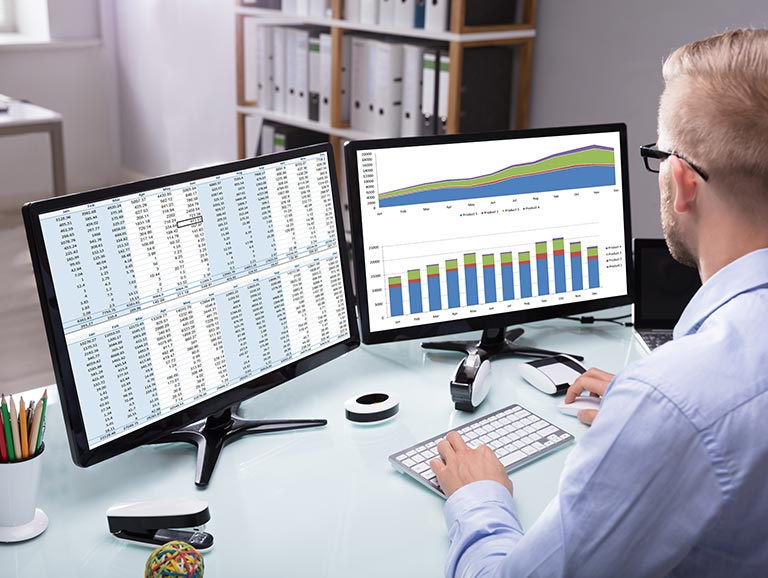The value of digital marketing lies primarily in its measurability. Being able to measure the results of advertising efforts in order to improve, optimise and increase the profitability of campaigns is one of the many benefits that digital transformation has made available to all. Today, businesses of all sizes have a wealth of opportunities to learn more about their customers and deliver a personalised experience.
The different types of data
Data can be classified into 3 types depending on how you collect it:
- First-party data is data collected directly by your company. For example, you can obtain it by placing a pixel on your website or application. The aim is to be able to track every interaction made by internet users via the different channels you use. All this data is usually gathered in a DMP (Data Management Platform) in order to have a holistic view of customer information.
- Second-party data , this is quite similar to first-party data, except that it comes from another company. The process, therefore, consists of buying data from a company that owns it.
- Finally, third-party data is data purchased from a company that has not collected it itself but has gone through a data aggregator. These aggregators are therefore intermediaries who buy data to resell it.

What data should you collect?
In the past, companies tended to think that the right strategy was to collect as much data as possible. This was a big mistake! To be useful, data must be qualified.
We recommend that you identify the data that will be useful for you and your specific needs. If you are an SME, you may not be able to collect all the data you want directly. A large volume will probably be too much to handle, and you may not have the time to analyse it and therefore exploit it properly. It is, therefore, better to focus first on a limited amount of data to collect in order to optimise usability and performance.
Why collect data?
Collecting data can serve many purposes, the key issue currently being the hyper-personalisation of the customer journey . Today’s consumers want a unique and relevant experience. How can this be achieved? Using intelligent data collection, you can get to know your customers better so you can deliver the personalised content they want.
And once you’ve mastered the art of data marketing, you can go even further and leverage the insights you gain by predicting future trends. Using analysis, you will be able to create models, accurate buyer personas and predict the behaviour of your customers and prospects.
How to collect data?
1. Conduct a pre-analysis
Before you even try to decipher your target’s behaviour and try to influence it, the first job is to accurately analyse the raw data to understand who your natural audience is. You need to have a comprehensive view of your current customers so that you can define clear objectives.
Are you going to focus on this target to grow your audience while keeping the focus on the same “type” of people? Will you try to move towards a different target than your current one? Will you segment your audience into different categories and create targeted campaigns for each? All these questions can only be answered after you have done a pre-analysis of the initial data collected.
2. Sort the data
When you start collecting data, not all of it will be relevant, and it will be necessary to sort through it. You will need to gather, clean and combine the data to get the most use out of it and unlock the potential it holds.
Gradually you will learn which data is worth collecting and optimise the process to avoid unnecessary mass collection. The final goal will be to connect different sources and link them to digital platforms, which will allow you to automate the activation of this data later on.
3. Analyse the data

The first step in analysing the data is to ensure that you understand it. Analysis is time-consuming and requires time, rigour and significant technical skills. You will need to test, improve and enable your dashboards to continuously evolve.
To obtain tangible and visually pleasing analyses, we advise you to use the services of a data analyst. They will be able to transform your raw data into clear and comprehensible dashboards for you and your employees. This will give you a general idea of the results obtained at a glance.
4. Use the data
You now know your current target group and have obtained data that is relevant to your needs. Now it’s time to use this data to improve your performance and meet your goals!
You can:
- Define target audiences to reach each market segment with the right message.
As we have explained, the data collected allows you to better understand who your potential customers are, what they do and what their interests are. With this knowledge, marketers can better communicate with them, tailoring content and messaging to correlate with what the consumer is really interested in. - Predict future trends in your users’ behaviour. Draw conclusions from your analyses and continue to refine your data marketing strategy. Examine which types of ads work best on your target audience, which traffic sources your customers come from and study their buying journey. By carefully analysing the interactions on your digital platforms, you can predict the actions of each target segment and determine how to act upstream to engage with them.

Meticulous and perfectionist, Céline specializes in the creation of SEO-oriented content. But these are not her only assets! She also puts her creativity at the service of our Social Media Strategy team to create ultra-targeted campaigns designed to convince and convert.



